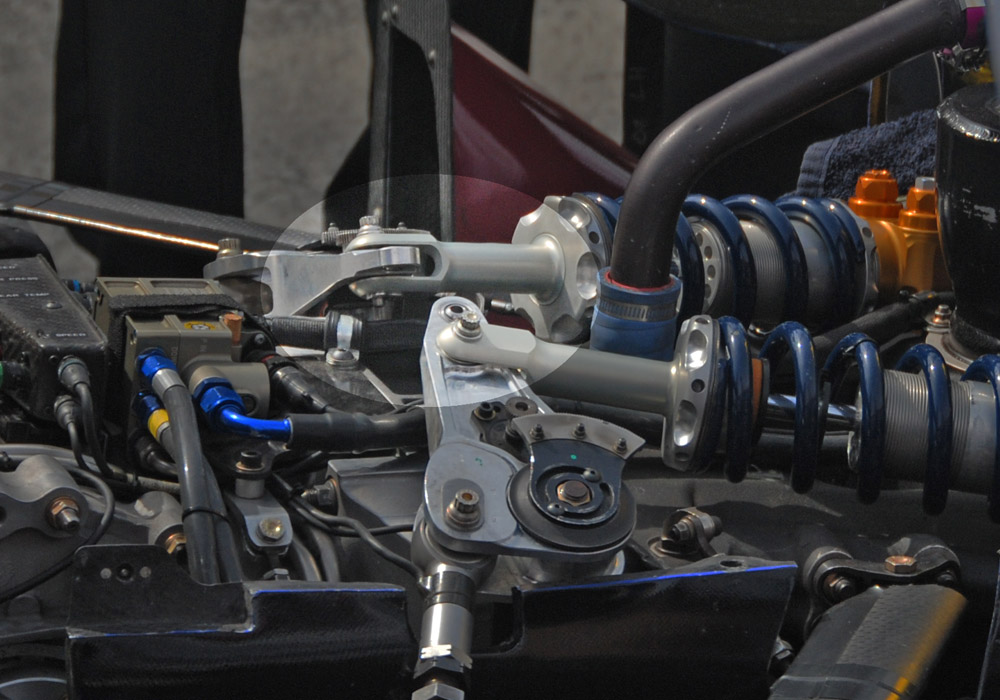Controversy continues over IndyCar ride control
 |
| The infamous Anti-roll bar (ARB) setup that makes the ARB act like a spring, providing additional bump control. |
 |
| The really trick setup: this one has an additional modification with a flange extending rearward that also provides droop control. |
 |
| The teams that have yet to catch up have no ARB setup at all, as evidenced by the empty bolt holes at the top of the rocker arm. |
The controversy over the "3rd spring" ride control issue that surfaced a few weeks ago when it was revealed that Team Penske was running some form of ride control on the cars, which was thought to be prohibited by IndyCar officials until a memo came out this week from the Indy Racing League saying it is now allowed.
The trick that Team Penske is using, and now the other teams are scrambling to adopt, is to use the anti-roll bar (also known as a sway bar) as a third spring rather than as an anti-roll bar as it was intended. In order to implement it requires a modification to the configuration of the bar so that it does not transfer load from one side of the car to the other during cornering to reduce leaning of the car, but instead act as a single spring holding up both sides of the car.
In theory when you remove the two regular springs from the car it should drop to the ground. Not so when the anti-roll bar has been modified to act as a third spring. Since the teams do not run an anti-roll bar on street and road circuits anyway, this allows them to put the device into use another way.
The intent of the change is to allow the four regular springs (two front and two back) to be softer so the car rides over the curbs and bumps better without bottoming out. Meanwhile, the anti-roll bar does not engage until the regular spring compress beyond a certain point, such as under heavy braking where the nose dives down. Once engaged the stiffer third spring helps to slow further diving of the nose of the car, or in any other scenario where the cars suspension flexes beyond a certain point. In other words, a form of ride control that allows you run the car closer to the ground on softer springs without bottoming out.
What has the other teams mad as hell is that they were misled by IRL officials in the past and were specifically told ride control was not permitted.
Ganassi Racing Managing Director Mike Hull told AutoRacing1.com, "Someone spotted a ride control device on the Newman Haas car in Brazil and that is when this all surfaced. Up until then most of the teams thought ride-control was prohibited.
"We do not have any problem with Team Penske. Our beef is with the IRL, and in particular Les Mactaggart (Senior Technical Director of the IRL). We asked if we could implement a similar ride control system a couple of years ago and we were denied by Mactaggart who told us in no uncertain terms that ride control was prohibited and that if it was found it would be taken off.
"The IRL needed to control the situation. Then they put a memo out this week that does not fully define what the function of a spring and anti-roll bar are. As it is right now all the teams are free to now implement ride control. That means spending money on something the fans cannot see and that does not improve the show for the fans and created an unfair playing field."
Instead of banning ride control so all the teams did not have to spend the money to develop it, the IRL was forced to allow it for everyone because if they did not, that would say they allowed Team Penske to run an illegal device all this time.
And that is what has some team owners steaming mad. One told us, who did not want his name used, that "there are far too many unwritten rules in IndyCar and no process in like they had in Champ Car where a team could ask for an interpretation of a rule and the answer from officials was distributed to all competitors automatically. There are things going on in this paddock that are appalling. Jokingly they are called "Rocket" rules, referring to the fact that when there is no written rule banning something they make one up (pull it out of the air) and deny you."
Justin Wilson told us the Dreyer & Reinbold is now looking at implementing it too. "In the past we were denied using it. Maybe we did not ask the question the right way," said Wilson. "However, I am not sure it really makes that much of a difference. Personally I think it is just a distraction that takes your focus off what Team Penske may really be doing."
Now that the cat's out of the bag and the IRL has approved ride control for IndyCars, and given how tenths of the second separate the top teams, look for all the teams to implement some form of ride control, a needless cost that does absolutely nothing to improve the show for the fans.
So sad, but oh so true. We doubt new IRL CEO Randy Bernard is going to put up with such nonsense in the future.
